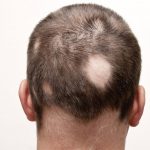 Is a particular disorder affecting hair growth (loss of hair) in the scalp and elsewhere.
Is a particular disorder affecting hair growth (loss of hair) in the scalp and elsewhere.
Irregular loss of hair on the scalp or body, alopecia totalis.
A condition in which the hair falls out in patches.
Alopecia areata is a common form of reversible hair loss which may be patchy, total on the scalp, eyebrows or eyelashes, or universal on the body. The onset is sudden at any age and the affected scalp-skin looks normal. The hair follicles remain intact but ‘switched off’ and usually hair growth recovers spontaneously. No consistently effective treatment is available but injections of corticosteroids, given with a spray gun into the scalp, may be useful. The regrown hair may be white at first but pigmentation recovers later.
Loss of hair in sharply defined patches usually involving the scalp or beard.
Autoimmune disorder that causes the affected hair follicles to be mistakenly attacked by a person’s own immune system; usually begins with one or more small, round, smooth bald patches on the scalp.
This is a condition characterized by round, often multiple bald patches on the skin. The skin in these areas appears normal, but the hairs at the edges of the patches may have shrunken bases, resembling a row of exclamation marks. These bare patches can sometimes blend into complete baldness. In some cases, individuals may also experience thinning and shedding of their fingernails. Poor health and nervous issues contribute to this condition, and for some, recurrent episodes may signal that the body is under significant stress. Alopecia areata can occur during puberty, pregnancy, menopause, and may affect multiple members of the same family. Typically, recovery occurs naturally within three to four months without the need for treatment.
